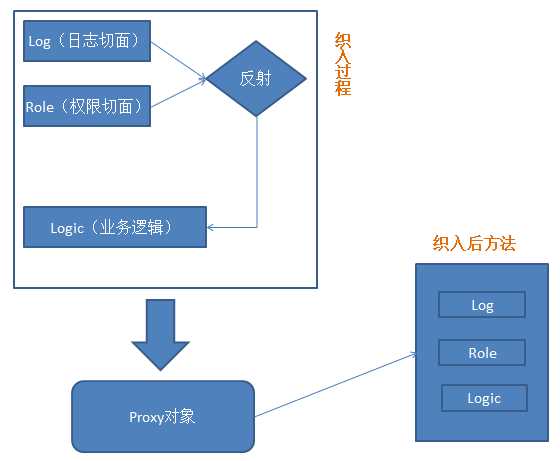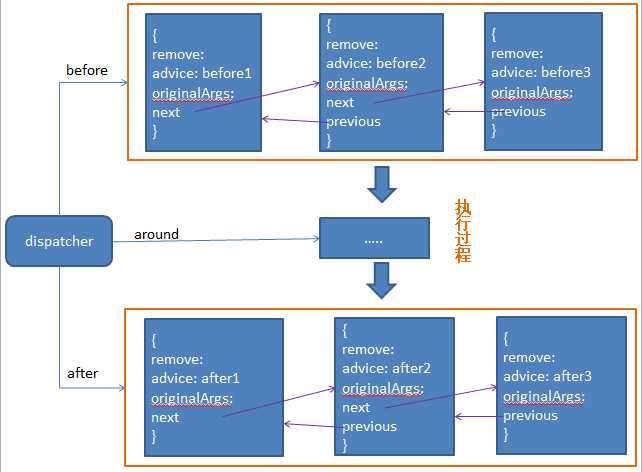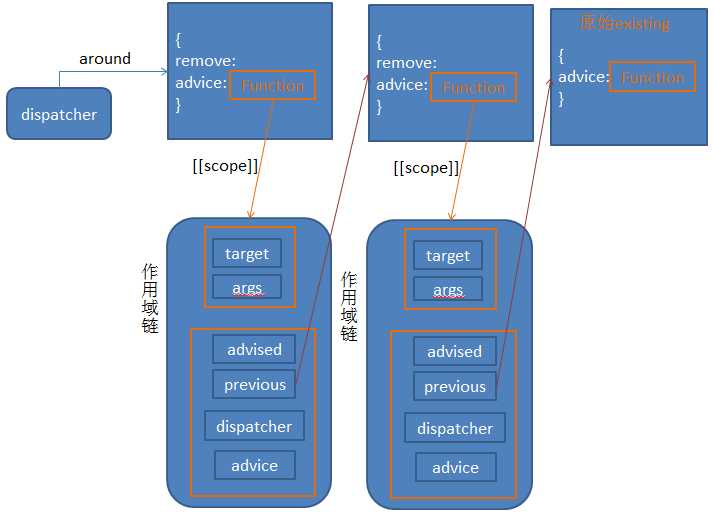标签:
dojo/aspect模块是dojo框架中对于AOP的实现。关于AOP的详细解释请读者另行查看其它资料,这里简单复习一下AOP中的基本概念:
生成代理对象的过程可以按照下图理解:

dojo/aspect模块代码主要分为两部分:

"use strict"; var undefined, nextId = 0; function advise(dispatcher, type, advice, receiveArguments){ var previous = dispatcher[type]; var around = type == "around"; var signal; if(around){ var advised = advice(function(){ return previous.advice(this, arguments); }); signal = { remove: function(){ if(advised){ advised = dispatcher = advice = null; } }, advice: function(target, args){ return advised ? advised.apply(target, args) : // called the advised function previous.advice(target, args); // cancelled, skip to next one } }; }else{ // create the remove handler signal = { remove: function(){ if(signal.advice){ var previous = signal.previous; var next = signal.next; if(!next && !previous){ delete dispatcher[type]; }else{ if(previous){ previous.next = next; }else{ dispatcher[type] = next; } if(next){ next.previous = previous; } } // remove the advice to signal that this signal has been removed dispatcher = advice = signal.advice = null; } }, id: nextId++, advice: advice, receiveArguments: receiveArguments }; } if(previous && !around){ if(type == "after"){ // add the listener to the end of the list // note that we had to change this loop a little bit to workaround a bizarre IE10 JIT bug while(previous.next && (previous = previous.next)){} previous.next = signal; signal.previous = previous; }else if(type == "before"){ // add to beginning dispatcher[type] = signal; signal.next = previous; previous.previous = signal; } }else{ // around or first one just replaces dispatcher[type] = signal; } return signal; }

function aspect(type){ return function(target, methodName, advice, receiveArguments){ var existing = target[methodName], dispatcher; if(!existing || existing.target != target){ // no dispatcher in place target[methodName] = dispatcher = function(){ var executionId = nextId; // before advice var args = arguments; var before = dispatcher.before; while(before){ args = before.advice.apply(this, args) || args; before = before.next; } // around advice if(dispatcher.around){ var results = dispatcher.around.advice(this, args); } // after advice var after = dispatcher.after; while(after && after.id < executionId){ if(after.receiveArguments){ var newResults = after.advice.apply(this, args); // change the return value only if a new value was returned results = newResults === undefined ? results : newResults; }else{ results = after.advice.call(this, results, args); } after = after.next; } return results; }; if(existing){ dispatcher.around = {advice: function(target, args){ return existing.apply(target, args); }}; } dispatcher.target = target; } var results = advise((dispatcher || existing), type, advice, receiveArguments); advice = null; return results; }; }
注意:dojo的处理过程中并不生成代理对象,而是直接更改原有的对象的方法。
关于aspect.after方法(before方法与其类似)的解释请看这篇文章:Javascript事件机制兼容性解决方案;aspect.around的由来在这篇文章Javascript aop(面向切面编程)之around(环绕)里有其一步步的演化过程。
本文给出aspect模块调用后的示意图:
before与after函数:

around函数:

var advised = advice(function(){ return previous.advice(this, arguments); }); signal = { remove: function(){ if(advised){ advised = dispatcher = advice = null; } }, advice: function(target, args){ return advised ? //一旦调用remove,adviced变为空,便会跳过本次环绕通知,进入上一层的advice方法。 advised.apply(target, args) : // called the advised function previous.advice(target, args); // cancelled, skip to next one } };
可以看到around函数中借用闭包形成环绕函数链。这里调用remove方法后并没有像before跟after中将通知方法彻底移除,注册过的环绕方法仍然会存在内存中,所以这个方法无法移除环绕通知,仅仅是避免了在函数链中执行它而已。内存无法释放,不建议使用太多。
标签:
原文地址:http://www.cnblogs.com/dojo-lzz/p/4492472.html